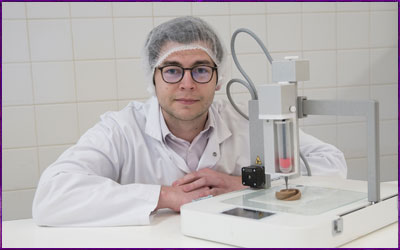Research into 3D-printing with food underway

Campden BRI has begun a research project to assess and evaluate how 3D-printing applications could benefit the food industry.
Ingredient scientist, Gael Delamare, who is leading the team, said:
"There have been major steps forward in 3D-printing in recent years and it has made a huge difference to many industries. However, applying the technology to the food sector isn’t straightforward. There are many factors to consider such as shelf-life, microbiological contamination, printing temperature, textures, rheology and ultimately whether different foodstuffs even lend themselves to being printed. All of these issues need to be catered for in order to meet the expectations of the consumer and to do so safely."
3D-printing of food is a rapidly growing technology and new printers are now becoming available that can be used for various types of food materials. These are typically paste-type materials which include chocolate, vegetable and meat purees, pancake batter, cream, cakes, and biscuits. The technology is capable of manufacturing product structures which cannot be achieved, or are difficult to achieve, using conventional technology. The project aims to provide an objective and independent evaluation of the capabilities and limitations of 3D-printing technology through practical trials on a wide range of food materials.
The team is working on a range of products and areas, including the potential of the technology for personalised nutrition based on the dietary requirements of different consumers groups, such as fortification with vitamin D, calcium and protein for the elderly population. Food could potentially be personalised further for specific deficiencies including anaemia, lack of essential fatty acids and dietary fibre. The project will also use an X-ray micro-CT scanner to scan simple and complex designs to explore the scope of the possible structures and shapes that could be replicated by printing food. The modification of rheological properties to improve printing quality will also be examined.
Delamare added:
"3D-printing may also have benefits for reducing process development and NPD times. Food waste could also be reduced as perishable products, which would otherwise decline in quality, could be printed on demand. The project will explore the challenges and potential of its application in the food industry. We’ll be reviewing the 3D-printing technologies, conducting practical trials and developing new personalised products in terms of shape, flavour, colour and nutrition."
A seminar is also being hosted in June, as part of the research project. Speakers from industry will cover cellulose as an edible ingredient, personalised food for elderly consumers and the use of insect materials in the production of sustainable 3D-printed food. Campden BRI’s specialists will also cover consumer perception, printable ingredients, the importance of rheology in 3D printing, food safety, shelf-life, legal considerations, and ingredient issues and limitations. The seminar takes place on Thursday 20 June at Campden BRI.
For further information on 3D printing contact: gael.delamare@campdenbri.co.uk +44(0)1386 842220.

